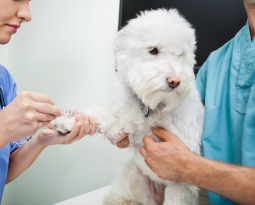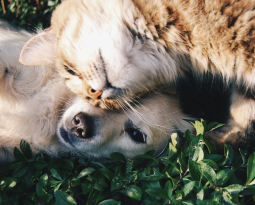Last time on the blog we talked about the different sounds our dogs and cats make in what we think are attempts to talk with us. A big component of that is the way they speak with their bodies, in dogs even more so! This time on the Acoma Animal Clinic blog we’re building up our Human to Animal language primer with how to read your dog’s body language!
Dog’s Body Language Cues
Tail Wagging
Tail wagging is the most commonly understood piece of body language… or is it? Typically people understand a wagging tail to mean a happy dog but the truth is a bit more difficult – the tail wag is tied to emotionally aroused. Whether that’s excited, worried, frustrated – any of those could be paired with a tail wag and the speed of the wag just means how excited/worried/frustrated/etc. they are!
There is some further nuance that recent studies suggest. For instance if the dog is waggint o the right of their body, this may correlate with positive emotions, while to the left it may be negative. The position of the tail in regards to the ground can also tell you more about the emotions of the animal. The higher the tail, the more assertive the dog may feel. If their tail is pointing to the ground or tucked, that is clearly a stress or fearful emotion being displayed.
Posture
The way a dog carries themselves can tell you a lot about their current mood and what they may be up to! The dog who is cowering, their head hunched and their body lowered to the ground is a obvious example of this (the dog feels scared or stressed). On the other side could be the dog standing tall with their weight shifted to the front. This shows interest, but it could also be aggressive.
Posture can vary by breed as well. Some breeds that have been bred for pointing for instance will raise a paw as a part of their job, signaling prey nearby. Other breeds may raise a paw too but that might show uncertainty or nervousness about their situation.
Hackles
You know the saying “Get’s my hackles up”? This comes from this behavior in dogs. The hackles is the fur across the shoulders and back of the dog and when they’re ‘up’ the hair is standing up fluffed. This shows clear emotional response, the most common being aggressive or angry, but not always negative. The dog may be stressed or especially excited or interested.
Facial Expressions
Believe it or not, dogs have similar facial features as people, but they aren’t used in the same way. The most obvious example of this is the smile. Humans smile because we are feeling joy and are happy about something. When a dog ‘smiles’ they are baring their teeth showing a warning to anyone who might be giving them problems. Paired with a growl it’s the dog saying ‘Watch yourself, I have a mouth full of pain coming your way!’ This specifically is when the sides of their mouths are opened showing the back teeth, not the front to be clear.
But there’s another way a dog can bare their teeth that isn’t aggressive. That’s when the dog shows the front of their teeth. This is a submissive grin. At the same time they will likely be squirming about, loose posture. The goal? To say ‘Everything’s fine I’m not a threat!”
Deciphering a dog’s body language is an important piece of truly understanding your pup. They will use posture, facial expressions and other physical ways to express themselves. Learn and understand your dog’s particular type of body language so you can always care for them in the best possible way! Knowing what’s normal behavior for them can help you identify when things are wrong much faster







